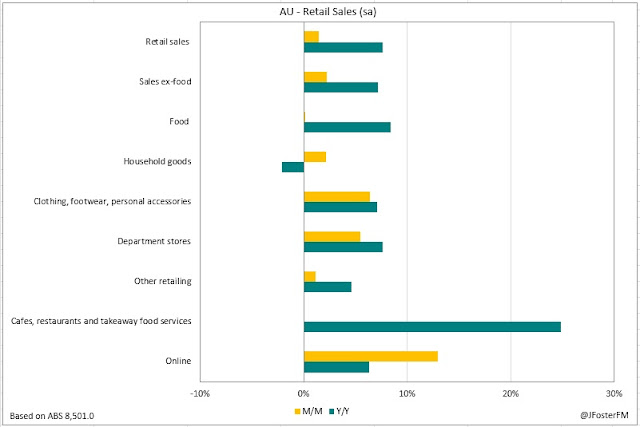A strong Black Friday sales period drove Australian retail sales to their fastest rise since the start of 2022 in November (1.4%). Discretionary sales lifted sharply as households brought forward spending ahead of Christmas to take advantage of discounted prices. The share of retail sales through online channels surged back to levels seen during Covid lockdowns.
Retail Sales — November | By the numbers
- National retail sales increased by 1.4% month-on-month to $35.9bn, well above the consensus estimate for a 0.6% rise. Upward revisions to prior months saw the previously reported decline in October (-0.2%) adjusted to 0.4% increase.
- 12-month retail sales slowed to 7.7% from 13.0%, largely reflecting base effects from lockdown reopenings in late 2021.
Retail Sales — November | The details
The Black Friday sales period generated a strong 1.4% lift in retail turnover in November, the fastest month-on-month rise since January 2022. The rise in the underlying discretionary spend (sales ex-basic food) was a sharper 2.3%, highlighting the bring-forward effect on Christmas spending encouraged by price discounting, likely accentuated in the current climate by cost-of-living pressures. Category gains were strongest in clothing and footwear (6.4%) and department stores (5.4%), both outturns posting at 9-month highs.
Online spending surged by 13% in November; a pace of that magnitude has previously only been seen during the Covid lockdowns in 2020 and 2021. Underscoring the popularity of the Black Friday and Cyber Monday period in 2022, the share of retail sales going through online channels jumped by 1.9ppts in the month to 12.6% — its highest since the Delta wave lockdowns in 2021 and comfortably above the levels reached at the outset of the pandemic in 2020. In turnover terms, non-food spending accelerated by 15.7%; however, Black Friday looks to have had broader effects as the food category also lifted sharply (6.1%).
Across the nation, there was a notable acceleration in retail sales seen in all states in November. Coming off gains of 0.6% in October, New South Wales lifted by 1.5% in November and by 1.7% in Victoria, with those increases accounting for 60% of the rise in national sales. The lift was also sharp in South Australia (0.1% to 1.3%), Western Australia (0.3% to 1.7%) and Tasmania (0% to 1.4%), though it was more modest in Queensland (0.4% to 1.0%). While Black Friday clearly added momentum to retail sales, there appears to have been an underlying resilience in spending across the states through the back half of 2022, even taking into consideration the inflationary effects that have played through to retail prices.
Retail Sales — November | Insights
The Black Friday boost to retail sales in November was notably stronger than expected. Spending was also stronger over recent months than previous reports had implied following revisions to the ABS's seasonal adjustments. This puts retail sales on a stronger footing if an unwind comes through in December. Despite headwinds from cost-of-living pressures and weak sentiment, household spending was resilient over the back of 2022 supported by the very strong labour market and accumulated savings. Those supports hold the key to where household spending heads in 2023.







